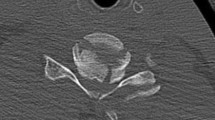Abstract
Anterior subluxation (AS), or hyperflexion sprain, generates a disproportionate level of concern in emergency medicine. Anxiety related to this injury arises from the fact that AS may produce delayed mechanical instability of the cervical spine, with resultant pain and neurological impairment. Furthermore, its radiographic presentation may be very subtle, and it may be impossible to reliably diagnose or exclude this injury using standard screening radiographs. Additional studies, such as flexion–extension (FE) radiography and magnetic resonance (MR) imaging, are often used in the acute setting to assess injury status and radiographically exclude AS injury. There are a number of reasons to discourage this latter practice, which can represent an impossible attempt to “radiographically clear the cervical spine” of blunt trauma patients with “100 % certainty.” This is because AS is an uncommon lesion, and the neurological deficits secondary to delayed instability are almost always minor and transient. Furthermore, AS is usually not entirely occult on screening plain films (which are typically “abnormal” even if in nonspecific ways). Finally, FE imaging, done acutely in the presence of spasm, is probably unable to exclude this diagnosis reliably, even when plain films are normal, and emergent MR, probably the most accurate technique, is not widely available. Risk stratification provides a rational alternative approach for assessing injury status. Low-risk patients may be spared further imaging provided they are given appropriate precautionary return instructions. High-risk patients require emergent evaluation by an experienced spine specialist, and may benefit from advanced imaging. Patients at moderate risk may be best managed with symptomatic treatment, warnings to avoid significant physical activity, and delayed FE imaging and evaluation by a spinal specialist. They should also be instructed to seek immediate medical attention if they develop any indications of delayed instability, including severe pain and /or neurological signs. This stratified approach not only increases the likelihood that delayed subluxation will be recognized before it leads to chronic instability, but frees clinicians and radiologists from the quixotic burden of trying to “clear” the cervical spine with 100 % certainty in the acute setting.
Similar content being viewed by others
Author information
Authors and Affiliations
Rights and permissions
About this article
Cite this article
Mower, W., Clements, C. & Hoffman, J. Anterior subluxation of the cervical spine. Emergency Radiology 8, 194–199 (2001). https://doi.org/10.1007/PL00011902
Issue Date:
DOI: https://doi.org/10.1007/PL00011902




